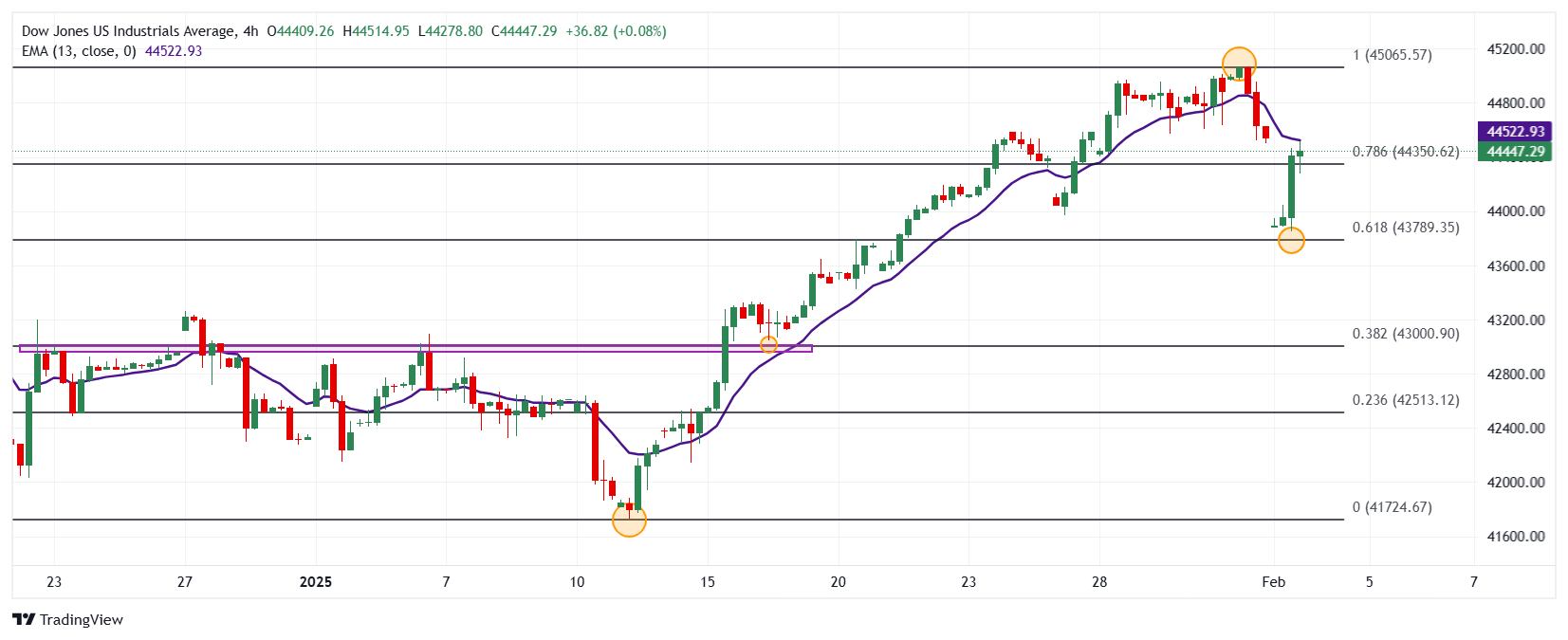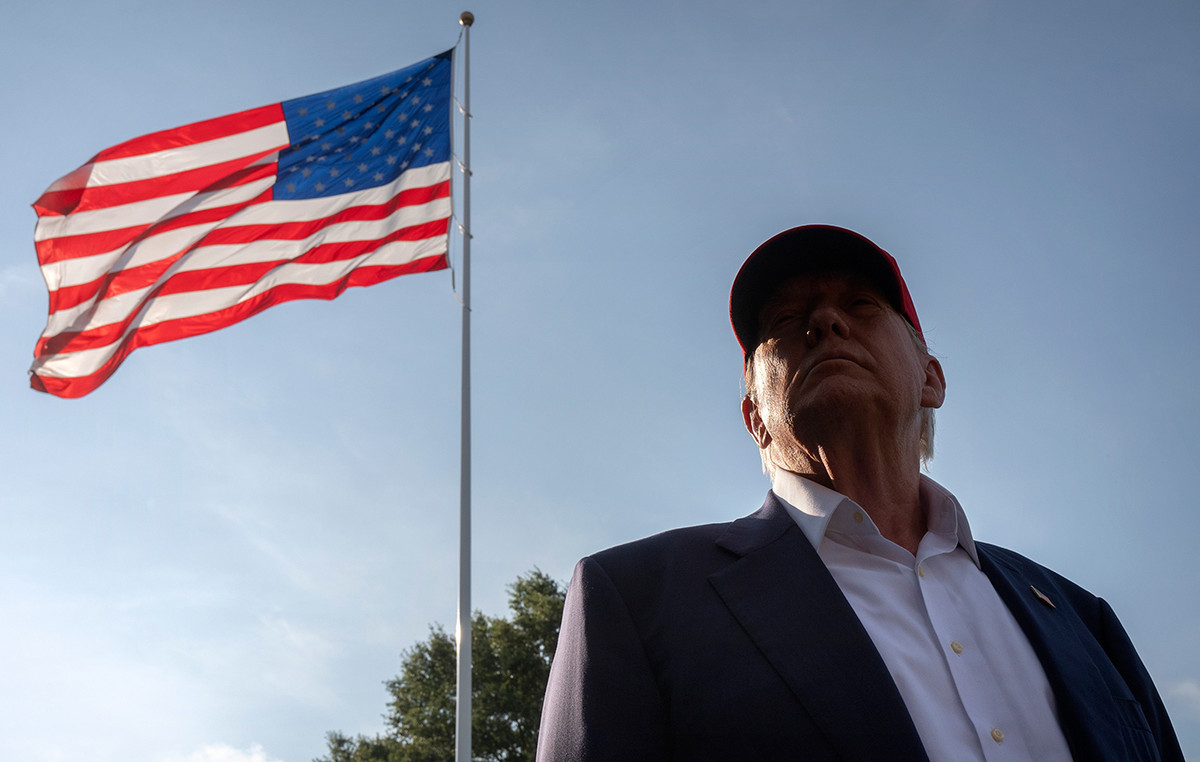- Dow Jones falls 0.42% today.
- The Nasdaq 100 loses 0.82% in the day, dragged by PDD Holdings (PDD) and Tesla (TSLA).
- The S&P 500 goes back 0.74% daily, weighed by modern (MRNA) and Blackrock (BLK).
- Donald Trump maintains his tariff rhetoric, causing market volatility.
The Dow Jones established a daily maximum in 44,514, where it attracted vendors that led the index to a minimum not seen since January 21 in 43,848.
The Dow Jones industrial average opened at 43,884, while the Nasdaq 100 technological index began operating in 21,113. The S&P 500 began negotiations in 5,935, taking up the bassist perspective, in tune with the main stock market rates.
Nvidia Corporation and Apple take Dow Jones to negative field
The Dow Jones index falls 0.42% on Monday, currently quoting at 44,885.
The titles of Nvidia (NVDA) fall 3.29%, reaching minimum of September 11, 2024 in 113.01 $. In the same tune, Apple’s values (AAPL) go back 4.10% today, signing their third consecutive session with losses, reaching minimum of January 27 at 225.70 $.
The president of the United States Donald Trump has maintained a constant tariff threat, increasing the volatility in the markets. In this context, the Dow Jones spoke its second consecutive day down, reaching minimum of January 21 in 43,848.
The Nasdaq 100 is quoted down dragged by Tesla and PDD Holdings
The Nasdaq 100 technological index is 0.82% daily, operating at the moment over 21,287.
The shares of Tesla (TSLA) lose 6.52% today, reaching minimal not seen since January 3 at 374.36 $. On the other hand, the PDD Holdings Business Group (PDD) falls 5.22% in the day, reaching minimum of January 24 in 104.80 $ after the imposition of 10% of tariffs to the goods from China by the Government of Donald Trump
The Nasdaq 100 has reacted upwards since 20,970, minimum not seen since January 27, although it remains in a negative zone, falling 0.82% in the day.
The S&P 500 goes back to minimum one week before Donald Trump’s tariff rhetoric
The S&P 500 index falls 0.74% daily, operating at the time of writing in 5,992.
Modern (MRNA) values collapse 8.24% today, currently quoting at 36.17 $, reaching minimum of January 21 at $ 35.93. Similarly. Blackrock shares (BLK) decrease 4.78%. reaching minimum not seen from January 27 to 4.81%.
Based on information presented by the Institute of Offer Administration, (ISM) the United States Manufacturing Manufacturing Purchase Management Index rose to 50.9 points, improving the estimated 49.8 and the previous 49.3.
Technical Analysis of Dow Jones
The Dow Jones reacted upwards in a short -term support given by the minimum of February 3 in 43,848. The following key support is observed in 43,048, minimum of January 16 to the north, the key resistance is found at 445,068, maximum of January 31.
4 -hour graph of Dow Jones

Dow Jones Faqs
The Dow Jones Industrial Avenge, one of the oldest stock market indexes in the world, consists of the 30 most negotiated values in the United States. The index is weighted by the price instead of capitalization. It is calculated by adding the prices of the values that compose it and dividing them by a factor, currently 0.152. The index was founded by Charles Dow, also founder of the Wall Street Journal. In recent years it has been criticized for not being sufficiently representative, since it only follows 30 companies, unlike broader rates such as S&P 500.
There are many factors that promote the Dow Jones Industrial Average (DJIA) index. The main one is the added performance of the companies that compose it, revealed in the quarterly reports of business benefits. The American and world macroeconomic data also contribute, since they influence investor confidence. The level of interest rates, set by the Federal Reserve (FED), also influences the DJia, since it affects the cost of credit, on which many companies depend largely. Therefore, inflation can be a determining factor, as well as other parameters that influence the decisions of the Federal Reserve.
Dow’s theory is a method to identify the main trend of the stock market developed by Charles Dow. A key step is to compare the direction of the Dow Jones Industrial Avenge (DJIA) and the Dow Jones Transportation Average (DJTA) and just follow the trends in which both move in the same direction. The volume is a confirmation criterion. The theory uses elements of maximum and minimum analysis. Dow’s theory raises three phases of the trend: accumulation, when intelligent money begins to buy or sell; Public participation, when the general public joins the trend; and distribution, when intelligent money abandons the trend.
There are several ways to operate with the DJ. One of them is to use ETF that allow investors to negotiate the DJ as a single value, instead of having to buy shares of the 30 companies that compose it. An outstanding example is the SPDR Dow Jones Industrial Avenge ETF (day). Future contracts on the DJ allow the specular operators about the future value of the index and the options provide the right, but not the obligation, to buy or sell the index at a predetermined price in the future. Investment funds allow investors to buy a part of a diversified portfolio of DJ values, which provides exposure to global index.
Source: Fx Street
I am Joshua Winder, a senior-level journalist and editor at World Stock Market. I specialize in covering news related to the stock market and economic trends. With more than 8 years of experience in this field, I have become an expert in financial reporting.







